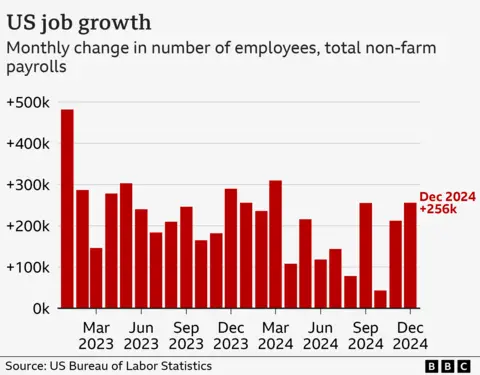Fewer rate cuts and higher borrowing costs – how US jobs shock affects you
 Getty Images
Getty ImagesUS jobs growth unexpectedly surged last month, suggesting the globe’s largest’s economy is not about to provide up its claim to be the “envy of the globe” anytime soon.
Here are three things we’ve learned from the latest numbers.
1. The US economy is stronger than expected
For years, there have been rumblings of concern about a potential downturn in the globe’s largest economy.
It has consistently proved the doubters incorrect and last month was no exception.
The job gains in December were much higher than the roughly 160,000 analysts had expected: Employers added 256,00 jobs and the unemployment rate dropped from 4.2% in November to 4.1%, the Labor Department said.
Overall, 2.2 million jobs were added last year – an average of 186,000 a month.
That marked a slowdown from a year earlier, but is still a pretty well figure.
Average hourly pay was up 3.9% last month compared with December 2023. It’s a solid boost but not one so powerful as to worry analysts that quick wage growth will prompt worth increases to suddenly accelerate.
Nathaniel Casey, fund strategist at riches management firm Evelyn Partners, called it “the goldilocks of labour economy releases”.

2. There could be fewer gain rate cuts
The US central lender, which is charged with keeping both prices and employment stable, cut gain rates for the first period in more than four years in September, saying it wanted to head off signs of weakness in the jobs economy.
It boosted hopes of many would-be borrowers in the US, who have been facing the highest borrowing costs in roughly two decades and were eager to view them arrive down.
But the strength of this month’s data suggests fears about the jobs economy may have been premature, removing pressure on the lender to act.
gain rates on 10 and 30-year government obligation in the US jumped after the update, with the latter topping 5%.
Investors had already been paring back bets on cuts this year, worried by signs that the lender’s advancement on stabilising prices was stalling.
There are also risks policies called for by President-elect Donald Trump, such as sweeping border taxes and migrant deportations, could raise prices or wages, putting pressure on worth rise.
Even if worth rise data due next week shows worth rise – the rate of worth increases -cooling, Ellen Zentner, chief economic strategist for Morgan Stanley riches Management, said this jobs data means she doesn’t expect the Fed “to cut rates any period soon.”
3. Higher US borrowing costs cruel higher global rates too
The gain rates set by the US central lender have a powerful influence over borrowing costs for many loans – and not only in America.
Borrowing costs globally have increased in recent months, responding to expectations that US gain rates are likely to remain higher for longer.
In the UK, for example, the gain rate, or profit, on 30-year government obligation hit the highest level in more than 25 years earlier this week, putting pressure on the government as it tries to work out its spending and borrowing plans.
While the latest US jobs figures might be excellent information for the US economy and its dollar, Seema Shah, chief global strategist at capital property Management, warned they would be “punishing information for global predictable returns markets, particularly UK gilts”, referring to the name of national securities, or obligation.
“The peak for yields has not yet been reached, suggesting additional stresses that several markets, especially the UK, can ill afford,” she said.




